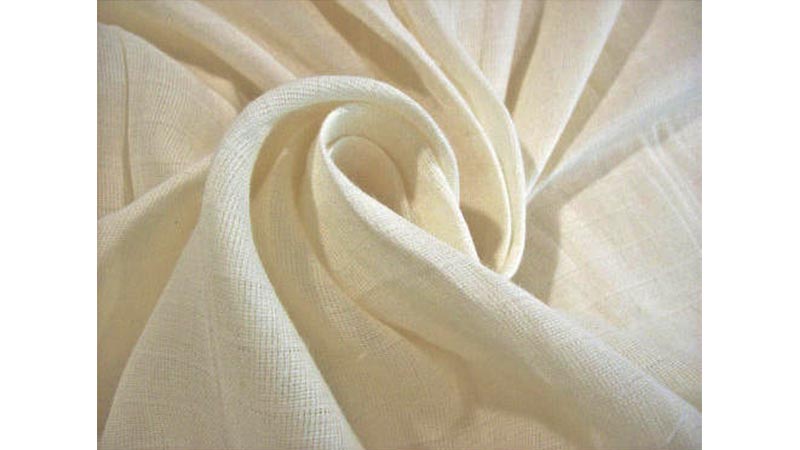Reviving Muslin for export


The Moghul time Muslin, the finest hand woven soft cotton fabric, is being revived aiming at its export opportunities. Muslin that grew under the royal patronage has a worldwide reputation as a glamorous attire. The globally famed 18th century Muslin was known for its magical production of the fine quality known, among many, as the ‘malmal’ which only the royal families in Moghul India and Europe could afford to use.
Muslin has been recognized as a cotton fabric of legendary lightness, characterized by distinctive designs. It was handwoven by certain groups of people who had expertise on the delicate craftsmanship. The fabric was produced from uncommonly delicate handspun yarn in villages Jangalbaree, Shonargaon, Teetbari, Dhamrai and Bajitpur all bordering Dhaka. Muslin was produced from a cotton plant that grew exclusively along the banks of a certain stretch of the Brahmaputra River. The finished cloth was sought by royalty and traded globally across countries of the Middle East, Europe and even beyond the Atlantic Ocean during 16th and 17th century, earning enormous revenue for those involved in its trade.
Commercial production of Muslin fabrics started nearly two hundred years ago-- woven from the finest quality of cotton known as Phuti Karpas (Gossypium arboreum var neglecta) that is believed to still exist in Bangladesh. A recent effort has been made to demonstrate Muslin’s potentiality in fashion business linking it to its commercial production. The demand for such fine fabric is increasing both at domestic as well as in world markets.
Meanwhile, the government has already obtained certificate from the World Intellectual Property Organization (WIPO) to claim Muslin as its own product in the Geographical Indicator (GI). Muslin recently drew attention of the Prime Minister Sheikh Hasina who showed special interests on the fabric. In her instructions the textile and jute ministry has taken a project titled, ‘Muslin yarn technology and Muslin cloth recovery’ in a bid to resume Muslin use.
Under the project, 'Recovery of the Golden Tradition of Muslin and the restoration of Muslin cloth', the work on Muslin cloth is progressing rapidly. The Bangladesh Knitting Board is implementing this project. According to the latest data, weaving progress has reached at 80 percent. Muslin's cotton and yarn identification research progressed 20 percent and spinning progressed 55 percent.
An expert committee comprising Rajshahi University, Bangladesh Textile University, Cotton Development Board, Bangladesh Textile Mills Corporation (BTMC) and Bangladesh Weaving Board are headed by the Chairman of the weaving board. The project began in June last year after approval from the Ministry of Planning. The first phase of the project will be completed next December.
Apart from the saree, if fashionable garments are made in line with international demand, it will be possible to take advantage of the export of high quality garments from existing basic quality garments. There will be variations in export products. But the price will be a bit higher. A Muslin sari will cost at least 50 thousand taka, say experts.
Chief of the planning and implementation of the Weaving Board Ayub Ali said, “We will hold meetings with entrepreneurs of the country to produce Muslin on a commercial basis so that they can be fully informed about the production strategy of the fabric, raw materials including cotton.” “This is because the government is bringing Muslin to a favorable level of commercial production. However, the entrepreneurs will work on export trade or commercial supply of Muslin in the local market,” he added.
He further said that as production efficiency increases, the cost will be reduced. A high value product will be added to the export. A group of researchers at Taiyama University in Japan have taken the research on Dhaka Muslin a long way. Due to Dhaka's claim as a GI product, they moved out of Muslin. A 10-member committee was formed under the leadership of Professor Manzoor Hossain, Director of Biological Science at Rajshahi University to take the project forward.
Professor Manzur told that, on their way to work, they found that the original Muslin samples could not be found anywhere. They went to the Victoria and Albert Museum in London to search for Muslin. According to Professor Manjur Hossain, the huge demand for cotton in the export-oriented garment sector can now be met with improved domestic cotton. Because such cotton is very useful in the production of high-value clothing.
However, contrary to this expectation, the executive director of a private research firm Ahsan H. Mansur said, such initiatives are good news for the nation. Through this step export-oriented garment products may diversify. Bangladesh will be able to take a strong position in the export trade by producing high-value garments, he added.

